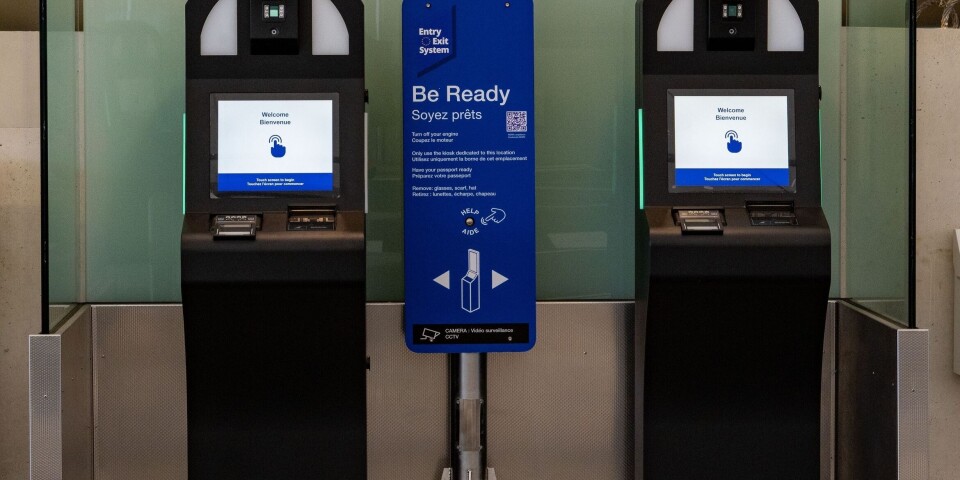Passengers subject to the new Entry/Exit System (EES) faced long delays at one major EU airport yesterday as the system launched - but travel to France appears to have been calm.
EES digital border check regulations came into force on Sunday (October 12), affecting non-EU visitors at at least one border crossing point (port, airport, physical border crossing, railway station) in every Schengen Zone country.
According to new phased-start regulations, by the end of the month 10% of eligible passengers must be entered into the new digital borders system.
Crossing points implementing it and numbers of passengers entered must ramp up over six months, towards full implementation at all points and for all eligible passengers by April 10. For the first two months, crossing points may also implement it without the collection of facial images and fingerprints if they wish.
While this phased start to the system allows for some breathing room – and for a time, border points are allowed to lift certain EES measures to ease congestion – long queues have been reported.
Prague airport sees brunt of chaos
Despite the option to gradually implement the regulations – France has chosen to do this – some countries such as Czechia (formerly the Czech Republic) decided to fully implement the system on launch yesterday.
Prague airport was the busiest location across the Schengen Zone to apply the measures from day one, having installed several ‘kiosks’ to take passenger data in Terminal 1.
Early morning flights to the Czech capital caused little issue, with border staff manually taking the data required to register travellers into the system.
However, queues from non-EU passengers – Britons, Americans, Turks, Australians, Egyptians, and many others who need to register for the system – quickly built up.
Data-collecting kiosks were not switched on despite the growing queues.
“All machines [are] still switched off, [wait times are] heading to an hour now. Fingers and eyes being done at the passport control desk,” a passenger told UK media outlet The Independent.
Waiting time increased to around 90 minutes according to passengers in the airport, leading to confusion for both arriving and departing travellers as queues threatened to merge into one larger mass.
Airport officials “started allowing Australian and British passport holders to use the EU channel to ease congestion,” said another passenger.
Despite EES also being used to register the details of passengers leaving the bloc – including those in the Schengen Zone at the time the regulations are being introduced – they were reportedly not taken by those leaving Prague airport.
If you have questions about EES, our article here has a list of common queries with answers.
France sees little struggle on day one
Despite the delays at Prague airport, other entry points rolling out the system yesterday received little media coverage.
In France, coach passengers from Dover and Folkestone’s Eurotunnel terminal were set to be affected by the system from day one.
Travellers using their own cars will see the system introduced on November 1 according to the most recent reports.
However, we have not seen or received reports of delays at French border crossings due to EES yesterday - which was as predicted by the Interior Ministry.
Officials told us on Friday October 10 (two days before launch day): "In France, the vast majority of border crossing points (including the port of Dover, London St Pancras station, and Eurotunnel in Folkestone) will begin using EES on a small scale between 14:00 and 16:00 for a few travellers, with or without biometric data collection.
"Therefore, nothing particularly noticeable is expected on October 12."
The ministry added that pre-registration kiosks and tablets would not be used immediately due to the low volumes of people at first, but would be activated in coming weeks.
Officials also stated, with regard to expectations that the machines will ask several 'travel questions', that border guards are able to turn these questions off and instead ask these (or choose not to do so) when passengers pass their booths.
The possibility of asking such questions (and potentially asking to see proof) is not new with EES, but already existed in the French and Schengen Borders Code rules, so many travellers may find they are not asked them still.
Despite the calm start in France over the first day, some industry experts have warned that delays are likely this winter as the measures ramp up.
Ryanair's chief executive, Michael O'Leary, has predicted that the system will "go wrong" and that travel experiences will be "bumpy and lumpy through the winter”.
The chief executive of UK travel agents’ body Abta, Mark Tanzer, said: “Looking at the short term, given the scale of the operation, there may be some delays, particularly at peak travel times.
“But countries will be stepping up their processes gradually and have the option to stand down the system to avoid significant and lengthy waiting times."
He is asking countries to remain "vigilant" and use such measures where necessary.
EU states were required by October 24 to provide the European Commission with a 'national roll-out plan for the progressive start', specifying how the required ramp-up thresholds and requirements would be met.
However, this is not publicly available and precise details of the roll-out at different sites for France are also not known, so travellers will have to be prepared.
The minstry told us there was "no specific timetable to be followed, either at European or national level, as each site can proceed at its own pace".
Have you had to register for the EES system yet? How was your experience, and which border point did you use? Tell us about your experience via feedback@connexionfrance.com




























